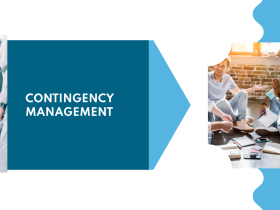What is Contingency Management ?
Contingency management theory is based on the assumption that people are motivated by rewards and punishments. This theory has been used to explain a wide variety of human behavior, including aggression, altruism, and even self-destructive behavior.
The basic idea is that people will respond to incentives in their environment, and that these responses can be predicted and controlled. Although contingency management theory has been very influential, it has also been criticized for its lack of scientific evidence.
To date, the most commonly used form of contingency management is the token economy. A token economy is a system for reinforcing desired behaviors. The tokens are usually small objects that are given out to reinforce behavior in exchange for other behaviors.
For example, an individual might be asked to tell a joke to get tokens. Tokens are later converted into money or some other reward. The token economy is effective for people with brain damage or other neurological disorders that affect impulse control.
How contingency management theory can be applied to the workplace.
Contingency management can be used to improve workplace attendance. If a person misses an appointment, they would lose money. This may sound harsh, but this is how it works in the real world. An employer might not want to take that approach, but it is effective. A contingency management system can also be used to improve the quality of work produced by an employee. Contingency management systems are particularly useful with people who have substance abuse or gambling addictions.
Contingency management is also used to encourage people to abstain from a substance, such as alcohol. In this case, the person might be given tokens or money for each day that they are not intoxicated. This can reward them for their actions and motivate them to change their behavior. Contingency management systems are also used in the treatment of people with behavioral addictions.
For example, a sex addict might be given tokens for each day that they do not have sexual intercourse. Contingency management can also be used to encourage people to make healthier choices in their lives, such as eating more vegetables or exercising.
Contingency management systems are useful for treating addictions because they provide a reward structure and make it easier for people to change their behavior. Contingency management systems can also be used for people who are not addicted to anything. For example, a parent might use a contingency management system by rewarding their child for completing chores around the house.
In addition to using contingency management systems, people can also use an intervention called “motivational interviewing.” This is a type of therapy that helps people develop skills needed for making healthier choices in their lives.
Psychotherapy is another treatment option for people with substance use disorders. This type of therapy focuses on helping the individual understand the underlying reasons why they use substances and other unhealthy behaviors. Psychotherapy can be used to help people develop healthier behaviors and improve their relationships with others.
The benefits of using contingency management in the workplace.
In 1960, Jack R. Gibb published the first paper on what would become known as contingency management theory (CMT). CMT is an area of research that examines how different environmental factors can influence behavior. The focus of CMT is on finding ways to change people’s behavior by manipulating these environmental factors.
One of the key ideas in CMT is that people are more likely to perform a desired behavior if they are given a reward for doing so. This is known as positive reinforcement. CMT can be used to help people with substance abuse problems. There are two main types of contingency management:
(1) token economy systems in Contingency Management
Token economy systems provide positive reinforcement for desired behavior by providing people with tokens that can be exchanged for rewards.
(2) voucher-based systems in Contingency Management
Voucher-based systems involve giving people vouchers that they can exchange for money or other rewards. This treatment is generally used for people who have severe addictions such as alcoholism and opioid dependence.
Behavioral activation (BA):
This intervention involves helping people with depression to identify activities that they find enjoyable, and then encouraging them to engage in these activities. BA is mostly used for people with mild to moderate depression.
Problem-solving therapy (PST)
This intervention involves helping people identify and change the problematic behaviors that may be contributing to their depression. PST is mostly used for people with mild to moderate depression.
If a person with depression has not responded to initial interventions, then the healthcare provider may recommend a more intensive form of treatment. There are several options for this. One is to increase the frequency of the current treatment, such as seeing a counselor once a week rather than once every two weeks.
Another option is to add another type of treatment that has been found to be effective in treating depression. For example, a healthcare provider may recommend adding a medication or changing the dosage or type of medication.
Another option is to add psychotherapy to the treatment. The type of psychotherapy will depend on whether the depression is diagnosed as major depressive disorder or dysthymia disorder. If the depression is diagnosed as major depressive disorder, the psychotherapy that has been found to be most effective is cognitive behavioral therapy (CBT).
CBT helps people make healthier choices and go about their day in a more positive way. But it may not be right for everyone.
Another form of psychotherapy called interpersonal therapy (IPT) may be a good choice for people who have suffered from depression for a long time and are having trouble with relationships. IPT focuses on current relationships and encourages people to repair or improve them. It also helps people cope with their feelings about other people.
The challenges of implementing contingency management in the workplace.
Contingency management programs are based on the idea that a person’s motivation to change is influenced by the consequences of their behavior. If people don’t meet goals, they will lose privileges. If they do meet goals, they will earn benefits.
Contingency management programs are often used to treat substance abuse.
For example, a person may be required to submit to regular drug tests in order to keep receiving their paycheck. What are the challenges of implementing contingency management in the workplace? One challenge is that people may not be able to control how much they use.
What happens if you don’t use the contingency management strategies?
If you are not using contingency management strategies, then your substance use may get in the way of your work performance or your relationships with other people. This can result in: Problems with your boss or supervisor Reduced time at work Decreased income from your job Loss of friends and relationships Negative consequences related to your substance use (such as accidents, problems with the police, or legal trouble) It is important to think about why you are using substances.
For example, if you are using substances to cope with stress or anxiety, it may be helpful to learn about other ways to cope. If you believe that your substance use is getting in the way of your relationships with others, it might help to talk about this with a friend or family member.
If you are using substances to deal with issues at home, you may want to talk about these issues with a family member or friend. If you feel that your substance use is getting in the way of your job, it may be helpful to talk about this with your boss or supervisor.
Conclusion:
Contingency management theory is based on the concept that people are more likely to change their behavior if they are rewarded for doing so. In the context of substance use, this means that people are more likely to stay sober if they are given something in return for staying sober. This could be anything from a monetary reward to a simple pat on the back. The key is to find something that will motivate the person to stay sober.
One of the most important things to keep in mind when using contingency management theory is that the rewards must be contingent upon sobriety. That is, the person must receive the reward immediately after they have achieved a period of sobriety. This will help to reinforce the desired behavior and make it more likely that the person will continue to stay sober in the future.
















